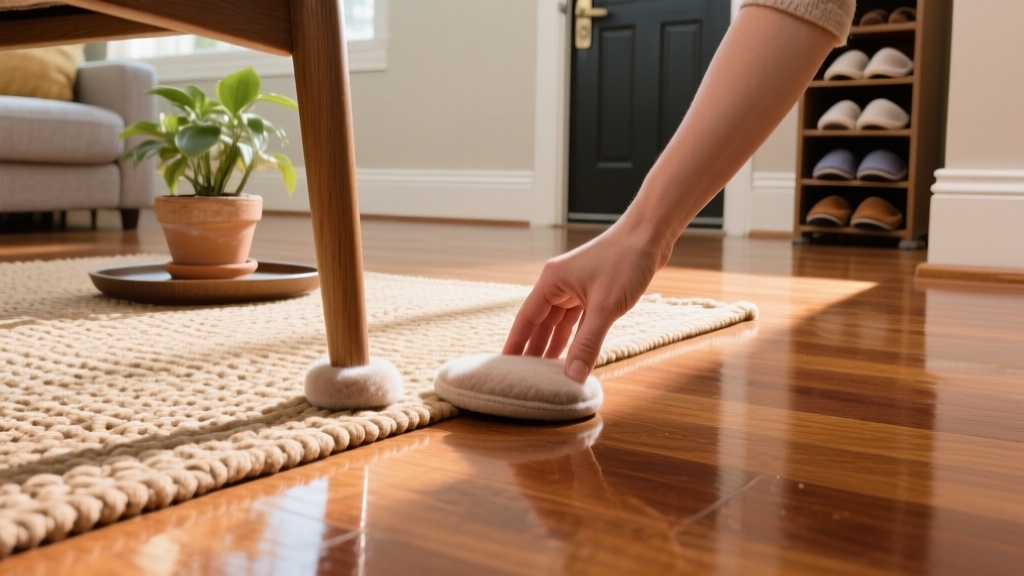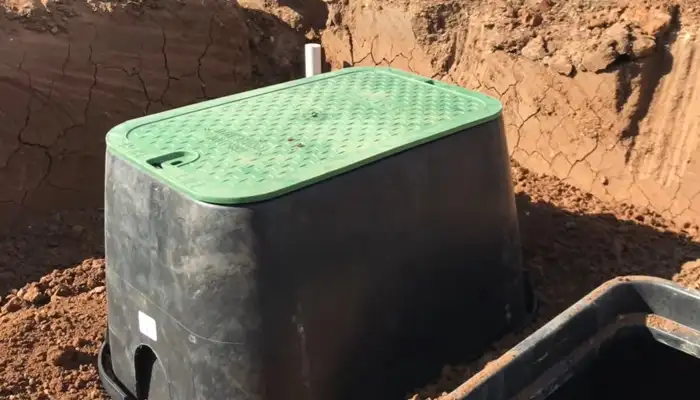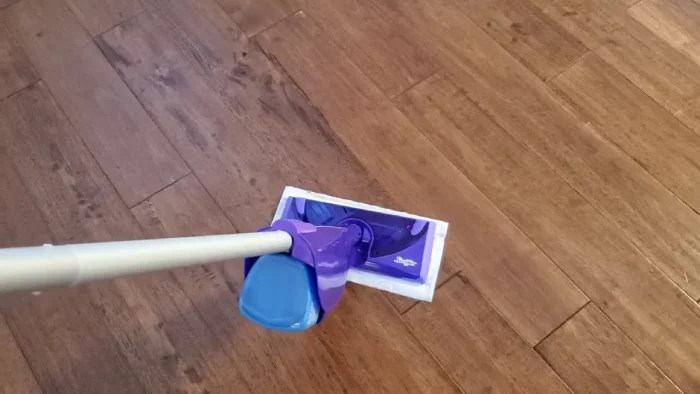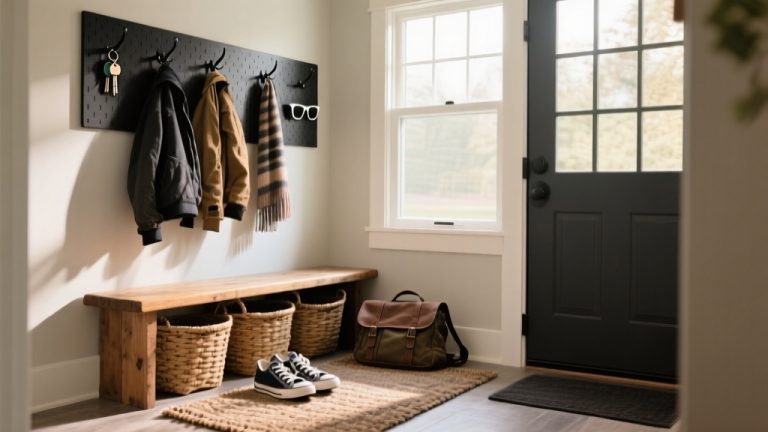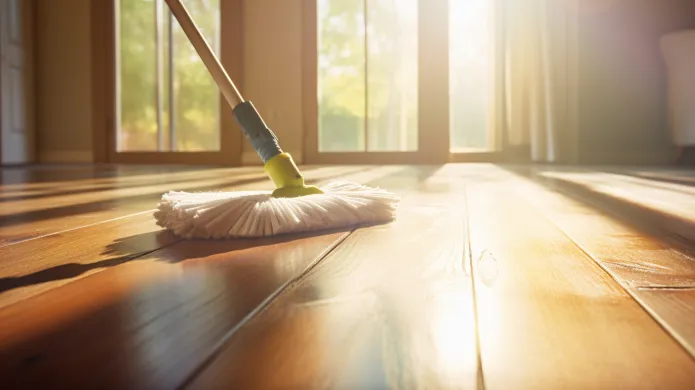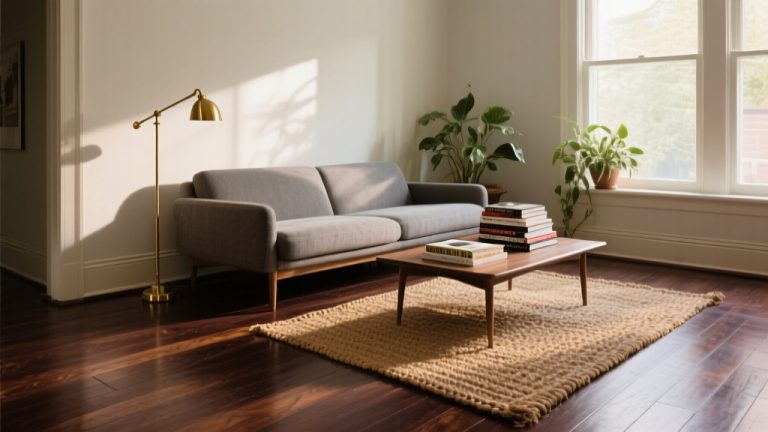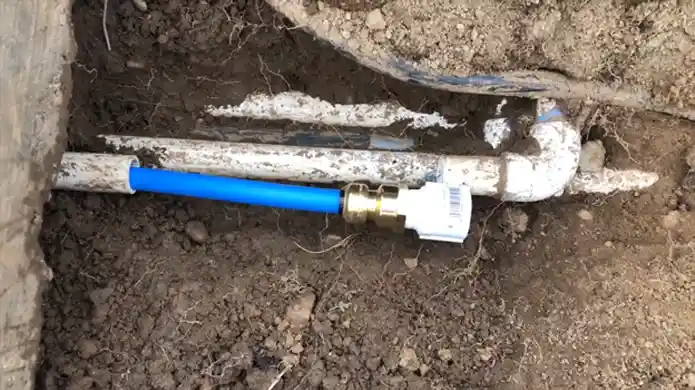How to Protect Hardwood Floors: Secret to Lasting
To protect your hardwood floors, start by ensuring the subfloor is stable, level, and clean, with moisture levels properly tested. Apply 2-3 thin, even coats of an appropriate sealant like polyurethane, sanding lightly between coats for durability.
Use felt pads on furniture legs and temporary covers during renovations to prevent scratches and damage. Maintain controlled humidity and clean spills promptly to extend floor life.
For detailed strategies tailored to unique situations and daily care, keep exploring the best practices ahead.
Key Takeaways
- Inspect and repair subfloor, then clean and level hardwood floors before applying protective finishes or coverings.
- Apply 2-3 thin, even coats of polyurethane or appropriate sealant, sanding lightly between coats for durability.
- Use felt pads on furniture legs and protective mats or films during renovations to prevent scratches and damage.
- Control indoor humidity and use UV-blocking window treatments to maintain floor condition and prevent fading.
- Employ temporary protective layers and limit floor access during renovations or heavy traffic to avoid wear and stains.
Preparing Hardwood Floors for Protection
Before installing hardwood floors, you must thoroughly inspect and assess the subfloor to make sure it provides a stable and level foundation. Verify the subfloor type and condition to select the appropriate installation method: nail-down, glue-down, or click-lock.
Check wood joist thickness and stability, ensuring they can support the flooring. For concrete slabs, measure moisture levels; they must remain below 3 lbs vapor per 1,000 sq ft in 24 hours to prevent damage. Assess flatness; height variation shouldn’t exceed 3/16 inch over 10 feet. Identify squeaks, damage, or loose boards and schedule repairs.
Remove debris and clean thoroughly to avoid adhesion issues. Level the surface by sanding high spots and filling low areas, achieving tolerance within 1/8 inch over 6 feet for ideal hardwood floor performance.
Cover the subfloor with an underlayment or moisture barrier such as asphalt-saturated felt or silicone vapor shield to prevent moisture problems and ensure floor longevity. Using a moisture meter to test the subfloor before installation helps prevent future warping and damage.
Applying Sealants and Finishes
When applying sealants and finishes, selecting the right type is essential to achieving both durability and aesthetic appeal for your hardwood floors.
Choose between polyurethane oil-based for durability, water-based for faster drying, penetrating finishes like oils and waxes to enhance grain, or acrylic and aluminum oxide for tough, low-VOC coatings. This selection depends on the desired appearance and environmental considerations.
Regular maintenance, including gentle cleaning methods such as vacuuming hardwood floors with appropriate attachments, helps preserve the finish’s longevity.
Begin by pouring sealant in small 5×5-foot sections, applying thin, even coats with a brush or roller along the wood grain to prevent streaks and bubbles. Feather edges between sections for a seamless look.
Allow appropriate drying times; water-based dries within hours, oil-based up to 24 hours.
Lightly sand between coats with fine-grit sandpaper to promote adhesion. Clean dust meticulously before recoating. Multiple coats, typically two to three, guarantee lasting protection and a flawless, professional finish.
Using Protective Materials and Accessories
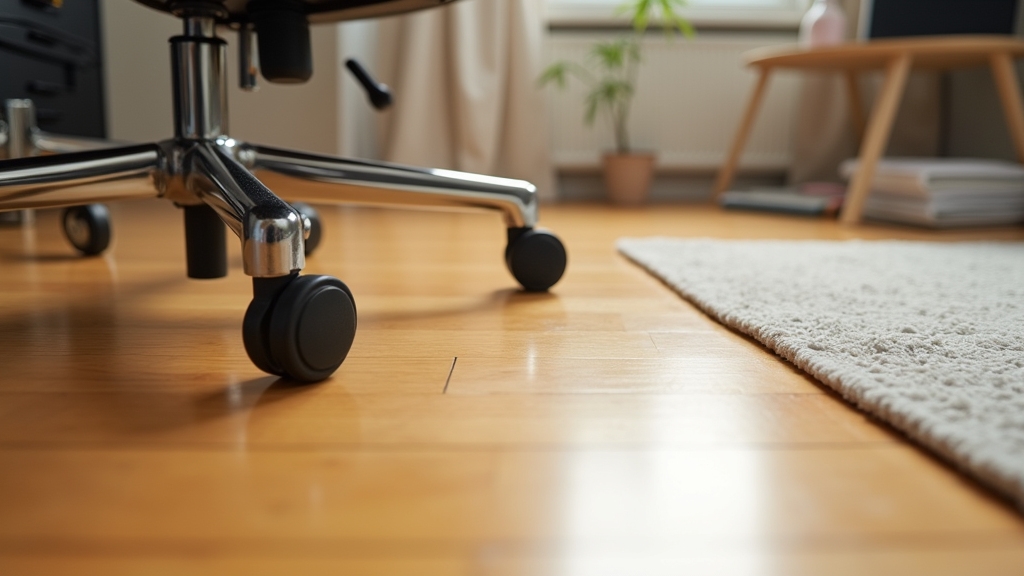
Although hardwood floors are durable, you’ll want to use protective materials and accessories to preserve their finish and structural integrity during everyday use and especially during construction or renovation.
Employing the right products prevents scratches, dents, moisture damage, and wear from heavy foot traffic or furniture movement. These products ensure long-lasting hard surface flooring protection that can also be suitable for tile, stone, laminate, and other surfaces.
Ensuring proper humidity control is also essential to maintain the flooring’s condition over time. Consider these essential protective items:
- Felt Pads and Rubber Feet – Attach these to furniture legs to cushion impacts and prevent scratching.
- Temporary Floor Pads and Builder’s Board – Use these during renovation to shield floors from tools, debris, and heavy traffic.
- Multi-Surface Film and Breathable Floor Covers – Apply these to guard against spills, paint splatters, and moisture while allowing airflow to avoid condensation.
Selecting and properly installing these materials guarantees long-term durability and reduces costly maintenance for your hardwood floors.
Special Considerations for Unique Situations
Protective materials and accessories play a crucial role in maintaining hardwood floors, but unique situations demand tailored approaches to guarantee ideal preservation.
Using furniture pads under heavy furniture can prevent dents and scratches that are common in everyday use. Applying a protective coat such as polyurethane can further enhance resistance to wear and tear.
For moisture-prone areas like kitchens, engineered hardwoods with moisture-resistant seals are vital. High-traffic zones require impact-resistant finishes, while sunlight-exposed rooms benefit from UV-blocking window treatments to prevent fading.
Temporary protective films are ideal for special events, and budget-friendly coverings can offer short-term defense.
| Situation | Recommended Protection | Key Benefit |
|---|---|---|
| Moisture Exposure | Engineered hardwood, sealants | Water damage resistance |
| High Traffic | Impact-resistant finishes | Enhanced durability |
| Sunlight Exposure | UV-resistant window treatments | Color preservation |
| Temporary Events | Protective films or mats | Prevents surface damage |
Tailor your protection strategy to your floor’s specific challenges for optimal longevity.
Protecting Floors During Renovation and Daily Maintenance
Since renovation activities and daily foot traffic pose significant risks to hardwood floors, taking proactive measures is essential to preserve their integrity. Begin by installing temporary protective layers such as plywood sheets for impact resistance or adhesive floor films for easy removal without residue.
Control access rigorously by marking zones with caution tape and establishing designated pathways to minimize unprotected floor exposure. Maintaining regular cleaning and maintenance before and during renovation helps prevent long-term damage and keeps the floors in better condition.
It is also important to maintain proper humidity levels to prevent wood expansion or contraction during these periods.
Maintain cleanliness through pre-renovation deep cleaning and immediate spill response to prevent staining or warping.
- Use wide-wheeled dollies and avoid dragging heavy objects to prevent gouges.
- Place protective mats under heavy equipment to absorb impacts.
- Employ area rugs with non-slip pads in high-traffic areas, rotating them regularly to ensure even wear.
Frequently Asked Questions
Can Hardwood Floor Protection Methods Vary by Wood Species?
Yes, hardwood floor protection methods vary by species. You’ll need to tailor finishes and treatments based on hardness, tannin content, and grain.
For example, White Oak requires tannin-blocking sealers to prevent discoloration. Softer woods like Hickory benefit from high-durability finishes to resist dents.
Moisture control is vital for species prone to swelling. You should adjust humidity levels and use mats accordingly to maintain each wood’s integrity and appearance.
How Do Temperature Changes Affect Hardwood Floor Protection?
Temperature changes cause hardwood to expand and contract, stressing the wood fibers.
You’ll need to maintain indoor temperatures between 60–80°F and humidity levels around 35%–45% to minimize this movement.
Rapid fluctuations increase the risk of warping, cracking, or separation.
Using HVAC systems, humidifiers, or dehumidifiers helps you stabilize conditions, preserving the floor’s integrity.
Protective finishes also reduce moisture absorption, enhancing durability against temperature-induced damage.
What Are the Environmental Impacts of Common Sealants?
Think of the air you breathe. Common solvent-based sealants release over 60 harmful VOCs, worsening indoor air quality and contributing to smog.
They pose health risks like cancer and reproductive harm, plus require hazardous disposal.
Water-based alternatives cut VOC emissions by about 85%, dry faster, and lessen environmental damage.
Choosing low or zero VOC sealants reduces toxic off-gassing, supports better indoor air, and minimizes long-term ecological harm.
Can Hardwood Floor Protection Interfere With Underfloor Heating?
Yes, hardwood floor protection can interfere with underfloor heating.
Protective finishes like oils or polyurethane add thermal resistance, which may reduce heat transfer efficiency.
To avoid this, you need to choose coatings with minimal thermal resistance and guarantee the total flooring system stays below 0.13 m²·K/W.
Also, maintain temperature below 27°C, use appropriate underlays, and avoid thick boards or heavy coatings to preserve heating performance and prevent damage.
Are There Eco-Friendly Alternatives to Traditional Floor Sealants?
Yes, you can choose eco-friendly alternatives to traditional floor sealants. Look for USDA Certified Biobased options like Vermont Natural Coatings PolyWhey or low-VOC water-based finishes such as BioShield Aqua Resin.
Natural oils like tung or linseed oil offer non-toxic, penetrating protection with a matte finish. Pair these with ultra-low VOC caulks and sealants like AFM Safecoat to guarantee durability while minimizing indoor air pollution and environmental impact.
From Preparation to Protection: Your Floor’s Best Defense
By carefully preparing your hardwood floors, applying the right sealants, and using protective accessories, you create a shield that stands firm against wear and tear. Think of your floors as a precious canvas; each step you take with proper care preserves its beauty and durability.
Whether during renovation or daily use, your attentive maintenance guarantees these natural surfaces remain flawless, letting their timeless elegance shine through every day.

